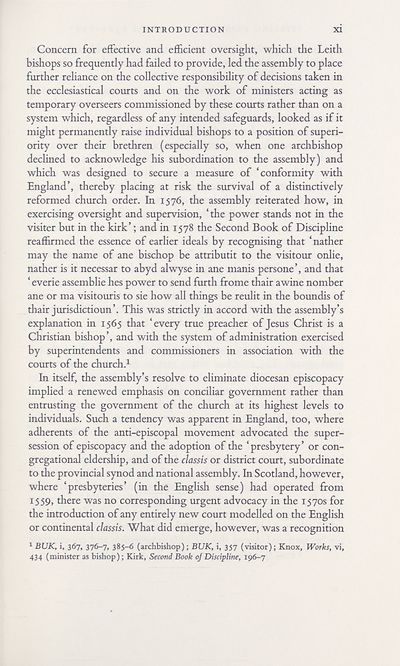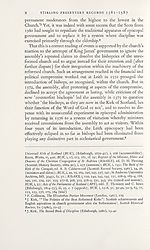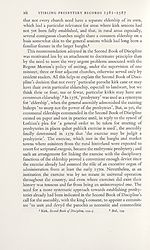Series 4 > Stirling Presbytery Records 1581-1587
(16) Page xi
Download files
Complete book:
Individual page:
Thumbnail gallery: Grid view | List view

INTRODUCTION
xi
Concern for effective and. efficient oversight, which the Leith
bishops so frequently had failed to provide, led the assembly to place
further reliance on the collective responsibility of decisions taken in
the ecclesiastical courts and on the work of ministers acting as
temporary overseers commissioned by these courts rather than on a
system which, regardless of any intended safeguards, looked as if it
might permanently raise individual bishops to a position of superi¬
ority over their brethren (especially so, when one archbishop
declined to acknowledge his subordination to the assembly) and
which was designed to secure a measure of ‘conformity with
England’, thereby placing at risk the survival of a distinctively
reformed church order. In 1576, the assembly reiterated how, in
exercising oversight and supervision, ‘the power stands not in the
visiter but in the kirk’; and in 1578 the Second Book of Discipline
reaffirmed the essence of earlier ideals by recognising that ‘nather
may the name of ane bischop be attributit to the visitour onlie,
nather is it necessar to abyd alwyse in ane manis persone’, and that
‘everie assemblie hes power to send furth frome thair awine nomber
ane or ma visitouris to sie how all things be reulit in the boundis of
thair jurisdictioun’. This was strictly in accord with the assembly’s
explanation in 1565 that ‘every true preacher of Jesus Christ is a
Christian bishop’, and with the system of administration exercised
by superintendents and commissioners in association with the
courts of the church.1
In itself, the assembly’s resolve to eliminate diocesan episcopacy
implied a renewed emphasis on conciliar government rather than
entrusting the government of the church at its highest levels to
individuals. Such a tendency was apparent in England, too, where
adherents of the anti-episcopal movement advocated the super-
session of episcopacy and the adoption of the ‘presbytery’ or con¬
gregational eldership, and of the classis or district court, subordinate
to the provincial synod and national assembly. In Scotland, however,
where ‘presbyteries’ (in the English sense) had operated from
1559, there was no corresponding urgent advocacy in the 1570s for
the introduction of any entirely new court modelled on the English
or continental classis. What did emerge, however, was a recognition
1 BUK, i, 367, 376-7, 385-6 (archbishop); BUK, i, 357 (visitor); Knox, Works, vi,
434 (minister as bishop); Kirk, Second Book of Discipline, 196-7
xi
Concern for effective and. efficient oversight, which the Leith
bishops so frequently had failed to provide, led the assembly to place
further reliance on the collective responsibility of decisions taken in
the ecclesiastical courts and on the work of ministers acting as
temporary overseers commissioned by these courts rather than on a
system which, regardless of any intended safeguards, looked as if it
might permanently raise individual bishops to a position of superi¬
ority over their brethren (especially so, when one archbishop
declined to acknowledge his subordination to the assembly) and
which was designed to secure a measure of ‘conformity with
England’, thereby placing at risk the survival of a distinctively
reformed church order. In 1576, the assembly reiterated how, in
exercising oversight and supervision, ‘the power stands not in the
visiter but in the kirk’; and in 1578 the Second Book of Discipline
reaffirmed the essence of earlier ideals by recognising that ‘nather
may the name of ane bischop be attributit to the visitour onlie,
nather is it necessar to abyd alwyse in ane manis persone’, and that
‘everie assemblie hes power to send furth frome thair awine nomber
ane or ma visitouris to sie how all things be reulit in the boundis of
thair jurisdictioun’. This was strictly in accord with the assembly’s
explanation in 1565 that ‘every true preacher of Jesus Christ is a
Christian bishop’, and with the system of administration exercised
by superintendents and commissioners in association with the
courts of the church.1
In itself, the assembly’s resolve to eliminate diocesan episcopacy
implied a renewed emphasis on conciliar government rather than
entrusting the government of the church at its highest levels to
individuals. Such a tendency was apparent in England, too, where
adherents of the anti-episcopal movement advocated the super-
session of episcopacy and the adoption of the ‘presbytery’ or con¬
gregational eldership, and of the classis or district court, subordinate
to the provincial synod and national assembly. In Scotland, however,
where ‘presbyteries’ (in the English sense) had operated from
1559, there was no corresponding urgent advocacy in the 1570s for
the introduction of any entirely new court modelled on the English
or continental classis. What did emerge, however, was a recognition
1 BUK, i, 367, 376-7, 385-6 (archbishop); BUK, i, 357 (visitor); Knox, Works, vi,
434 (minister as bishop); Kirk, Second Book of Discipline, 196-7
Set display mode to:
![]() Universal Viewer |
Universal Viewer | ![]() Mirador |
Large image | Transcription
Mirador |
Large image | Transcription
Images and transcriptions on this page, including medium image downloads, may be used under the Creative Commons Attribution 4.0 International Licence unless otherwise stated. ![]()
| Scottish History Society volumes > Series 4 > Stirling Presbytery Records 1581-1587 > (16) Page xi |
|---|
| Permanent URL | https://digital.nls.uk/126646347 |
|---|
| Description | Over 180 volumes, published by the Scottish History Society, containing original sources on Scotland's history and people. With a wide range of subjects, the books collectively cover all periods from the 12th to 20th centuries, and reflect changing trends in Scottish history. Sources are accompanied by scholarly interpretation, references and bibliographies. Volumes are usually published annually, and more digitised volumes will be added as they become available. |
|---|


